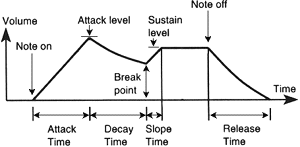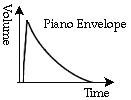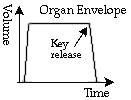FIT3084: Sound
In the previous lecture:
- PHP allows you to create, modify and delete mySQL database data easily!
In this lecture:
- What are the different attributes of sound?
- How is sound stored digitally?
- How may sound be employed effectively in multimedia production?
References:
There are many good books on electronic sound and music... most of them
have nothing to do with the WWW. This area is so vast that it is ridiculous
to pretend that a single lecture can do any more than scratch the surface. I
suggest you head to the library and start reading anything on the subject which
takes your interest!
Roads, C. "The Computer Music Tutorial", MIT Press 1996
...is however an excellent general text on the subject of computers and music.
Pitch
- Relative highness or lowness of a sound measured against a standard
scale (high tone, lower tone)
- High pitched tones (jet engine whine) perceived by the ear are high frequency
oscillations of the air
- Low pitched tones (thunder) are low frequency oscillations of the air
- Audible frequency range is ~20Hz - 20,000Hz
Timbre
- Tone quality or colour.
- Used to determine (for example) the difference between a tone played by
a bell and a tone played on a trumpet.
- Timbre is created by the kind and number of overtones.
- The tone heard as pitch is called the fundamental tone or the first harmonic
of a sound.
- Overtones are additional tones of higher pitch than, and superposed over,
the fundamental tone.
- Rich, full sounds (violin, voice) have many overtones, pure, thin sounds
(flute, triangle) have few overtones.

|
|
|
frequency spectrum of pitch C4
sin wave tone
(note the fundamental)
|
|
Duration
- Length of time a sound event occupies
- Short sound event (door slam)
- Long sound event (fog horn)
Loudness (Dynamics)
- Perceived intensity of a sound event
- Loud sound event (thunder)
- Soft sound event (termite eating your chair)
- The dynamics of sound event are the variations of its perceived intensity.
Attack - Decay
- Combination of dynamics & duration
Simple model:
- Attack time - time taken for a sound to reach a (maximum) level of
loudness.
- Sustain time - time sound remains at a constant level (often maximal).
- Decay time - time taken for sound to fall from sustained loudness
to zero loudness.
- Attack / Sustain / Decay defines a sound envelope.
More completely specified envelope (ADSR):
Different sounds have different envelopes:
- The envelope of the sounds produced by some instruments may be controlled
by the musician (eg. trumpet, violin, flute)
- A jet engine and a car passing in the street have gradual attacks and decays.
- A pedestrian-crossing click and a hand clap have rapid attacks and decays.
- A bass drum has a rapid attack and a gradual decay.
- Can you think of a sound with a gradual attack and a rapid decay?
Digital Audio
- Analogue sound vibrations are continuous pressure waves.
- Digital storage of sound vibrations requires sampling the wave at
regular intervals to record its amplitude.
- Sampling rate: number of samples per second
- Common sampling rates: 11.025kHz, 22.05kHz, 44.1kHz
- Sounds captured at high sampling rates
- High storage costs
- High quality
...and vice versa!
- Number of bits to encode the amplitude of a sound sample also determines
how accurately the wave will be represented. (To record a high frequency sound,
you need to sample the rapidly oscillating wave often.)
- Common bits per sample: 8, 12, 16
- The dots in fig 3 are individual samples
- Lots of dots per second = high sampling rate
- Lots of different dot heights requires lots of bits per sample. (eg. 8 bits
store 256 different heights)
Music, Sound or Noise?
- Noise is sound that bothers you.
- Sound is not necessarily noise that doesn't bother you!
- Music is sound you listen to on a recording or at a performance.
- Musicality concerns the role sound plays rather than being an attribute
of the sound itself.
- Not everyone wants to listen to the same sounds...
- What is music to you in one circumstance is noise to you in another
(and is always noise to your neighbours)
- Not everyone agrees on these definitions. I might not like them myself tomorrow!
- Be wary of setting up WWW pages with sound. People might find them really annoying. At the vey least, offer people a control to turn the sound off.
Sound For Moving Pictures (e.g. Animation)
 |
Literal Sounds: emerge from a sound source to which the sound refers.
- Dialogue
- Sound effects
- Source-connected (source on-screen) or source disconnected (source off-screen)
- Source-disconnected literal sounds evoke a visual image of the source
E.g. If you could hear this girl singing and the muffled sound of music being played through her headphones, these two sounds would both be literal and souce connected.
If you could hear her boyfriend in the background shouting, "Can you get the telephone?" and the sound of the telephone ringing, the former sound would be literal, source-disconnected dialogue and the latter would be ... what? |
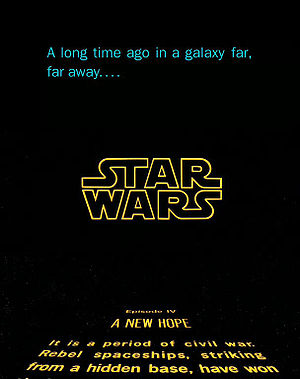 |
Non-literal Sounds: are not intended to convey a literal meaning, nor
be identified with a source.
- Music
- Source disconnected non-literal sounds do not evoke a visual image of the source
E.g. Do you picture a classical orchestra playing the Star Wars theme in outer space as the movie begins?
Sounds (like colours) can evoke or
describe moods, places, times, attributes (heavy,
rough, cold) and much more! |
Recording Sounds
- Sounds can easily be recorded using direct to digital means (PC, iPod, hard-disk recorder etc.).
- Use a good microphone
- Eliminate / avoid background noise where possible (eg. record in a studio, not in a noisy café).
- Record source material at the highest sampling rate where appropriate.
- Record source material at the highest possible level without clipping (i.e. without over-powering the recording device with very loud sounds).
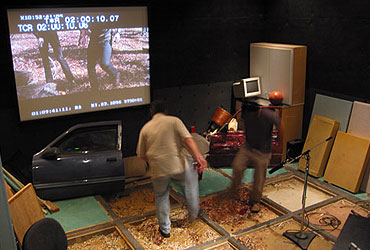 |
The creation and recording of sounds in a studio as video/film footage plays
is known as foley.
(E.g. Foley artists place footsteps, slam or knock on doors,
drum fingers etc. where these sounds were impossible to record well in
the field.)
Improvise with sound effects...
pop paper bags, tap pencils, break glasses, crumple plastic bags, strike matches,
wobble cardboard, walk in trays of gravel... there's no shortage of sound creating paraphernalia! |
Sounds for Interfaces
- Sound attracts attention independent of the user's current visual focus
- Sound can confirm an operation
- Sound can alert a user to a special event (eg. error, completion of computation...)
- Sound cannot be localized to an event on screen
- Sound must be accompanied by a visual cue.
- Sound must be approximately synchronized with a visual event (not delayed).
- Choose sound attributes to suit purpose.
(Eg. Siren is not much use to indicate a normal keystroke when typing. A quiet
'click' is useless as a reactor meltdown warning!)
- Be consistent (always!)
Web Sound
Down-loadable audio digital sound files are down-loaded in total
by a user before playback using a helper application.
Common digital audio file format extensions:
- AIFF (Apple sound file format)
- AU (Unix / Sun audio file)
- WAV (Windo$e sound file format)
- Quicktime, MPEG, AVI have both audio and video channels.
- MP3 compressed digital audio (lossy) that discards sound data that the ear
is not supposed to be able to hear.
- Include a down-loadable sound file in a web page like this:
<A HREF="path/mySound.mp3">soundName</A>
Streaming audio digital sound files run in a real-time stream
to client. The client plays as much of the file as possible as it is received.
Format: RA (RealAudio)
- RealAudio files are played by a free 'Real Audio Player' application on
the client machine.
- To set up RealAudio to play from your web site:
- Turn normal digital audio files into RA files using the free RealAudio
encoder.
- Create a metafile containing links to one or more audio
files....
pnm://www.domainName.com/mySoundBeep.RA
pnm://www.domainName.com/mySoundBlorp.RA
- Call the metafile something (soundsBurp.ram)
- Put a link to the metafile in your web page:
<A HREF="path/soundsBurp.ram">Bleep</A>
- Speak to the sys-admin and ensure the server is configured to handle
files of extension .ram as being of MIME type 'x-pn-realaudio'
- And sadly, just when you were excited: buy the RealAudio server software
$$$
- OR happily, install the free personal copy which allows (only) 2 connections
at once!
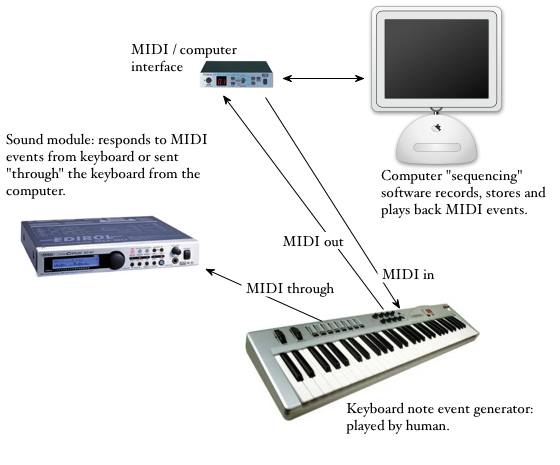 |
MIDI - Musical Instrument Digital Interface
- A protocol for communication between digital musical instruments.
- A stream of MIDI messages instruct instruments such as synthesizers to:
- Play a note of a certain pitch
- Play a note on a certain instrument or sound module
- Stop playing a note
- Alter sound parameters (loudness, envelopes, effects etc.)
...and lots more!
|
The image above shows a traditional, basic MIDI instrument set up.
- A human plays the keyboard to generate MIDI note events.
- MIDI events can be saved on the computer and/or sent to the sound module.
- The sound module has onboard software and hardware to synthesize audio waveforms (e.g. mimicking traditional instruments or creating new kinds of synthetic sounds).
- The MIDI interface allows the MIDI events to be saved on the computer using software known as a sequencer.
- The sequencer can also play back the notes it has recorded to trigger the sound module without the human having to keep playing.
- In this way a human can build up complex musical pieces a part at a time in the sequencing software to be synthesised simultaneously by the sound module.
- Sound synthesis can also be conducted directly on the computer, eliminating the need for the dedicated sound module.
On the WWW, it often makes sense to send MIDI music files because they are much smaller than digital audio files that store sampled waveforms.
- Only the MIDI note info. needs to be sent to the client.
- The client then uses a software synthesiser to create sound from the MIDI events it receives.
- Mobile phone ringtones are often encoded this way.
This lecture's key point(s):
- Five major attributes of sound: pitch; timbre; loudness; attack/decay
(envelope) and duration.
- Digital sound is an encoding of analgoue air-pressure waves at a certain
sampling frequency.
- Sound may be used to improve a user interface but it may also annoy a
user if used inappropriately.
- Digital sound files may be distributed via the WWW.
Courseware | Lecture notes
©Copyright
Alan Dorin 2009



